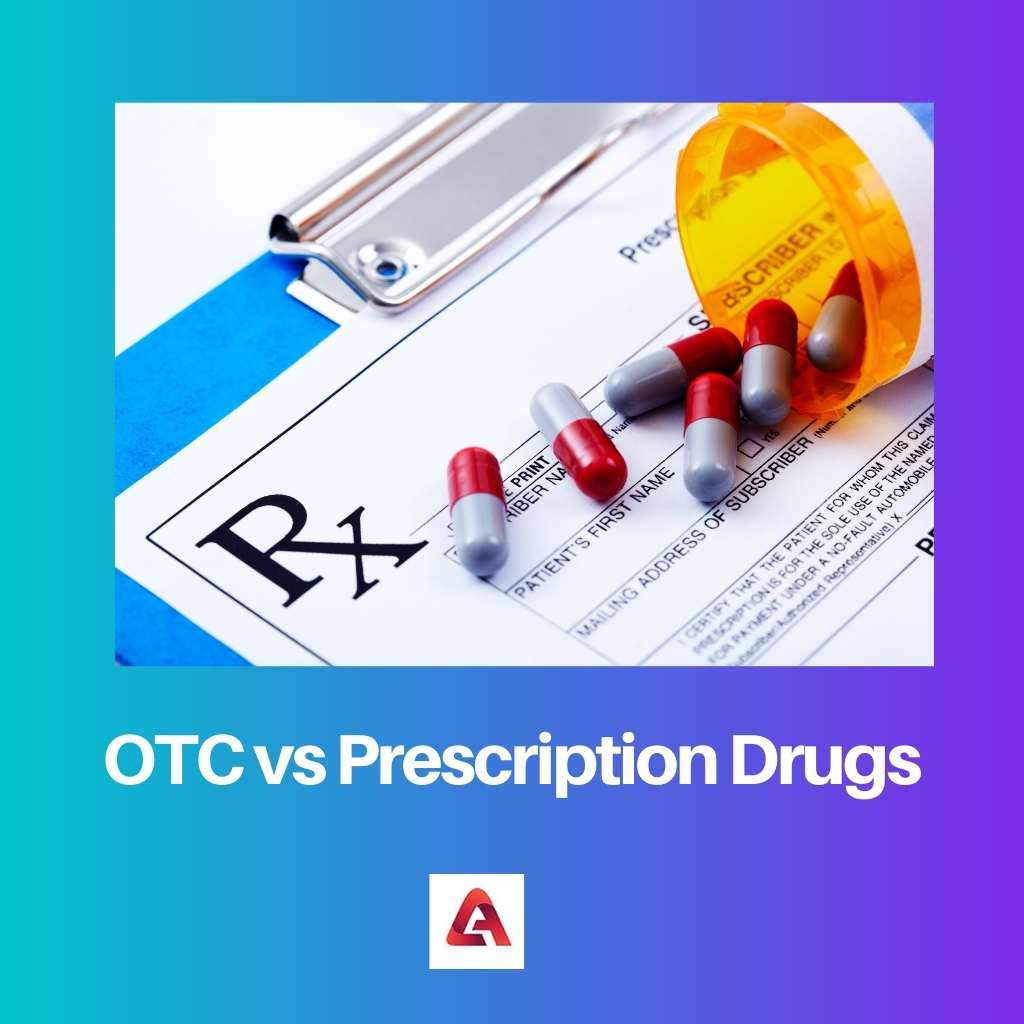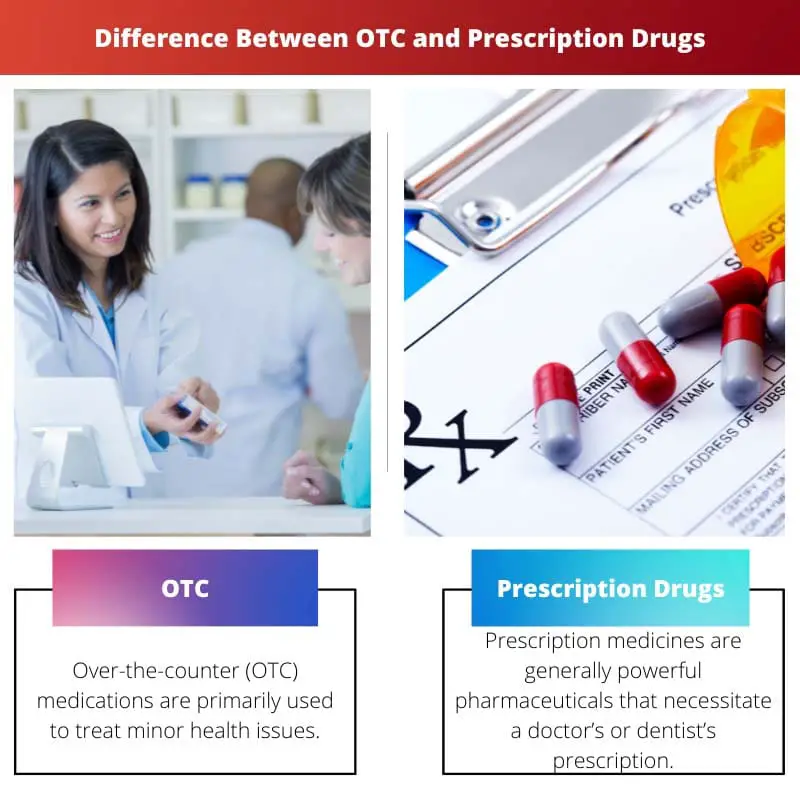A drug is a chemical used to diagnose, treat, prevent, or mitigate illness. Prescription-only and over-the-counter (OTC) medications are the two main types of pharmaceuticals.
Both prescription and over-the-counter pharmaceuticals have a role in enhancing individuals’ health and well-being worldwide. Factors like side effects and safety are closely monitored in both types of medications.
Key Takeaways
- Over-the-counter (OTC) drugs can be purchased without a prescription, whereas prescription drugs require authorization from a healthcare professional.
- OTC drugs are considered safe for most people to use and have a lower risk of side effects, whereas prescription drugs may have a higher risk of side effects or interactions.
- Prescription drugs are used for more serious health conditions, while OTC drugs are used for minor ailments or preventive care.
OTC vs Prescription Drugs
OTC drugs are medications that can be purchased without a prescription from a healthcare provider. They are available in drugstores and supermarkets. Prescription drugs can only be obtained with a prescription from a healthcare provider such as a doctor or nurse practitioner.

Over-the-counter (OTC) medications are primarily used to treat minor health issues. Some OTC medications may be found in supermarkets, while others can only be found in pharmacies.
The buyer needs to speak with a pharmacist to access some of them. OTC drugs allow individuals to relieve many bothersome symptoms and cure some diseases without visiting a doctor.
Prescription medicines are potent pharmaceuticals that require a doctor’s or dentist’s prescription. Prescription drugs can help treat a wide range of disorders when taken as directed by a doctor.
Attention deficit hyperactivity disorder and narcolepsy can both benefit from stimulants. Anti-anxiety, anti-panic, and anti-sleep medications are all CNS depressants. Pain, coughing, and diarrhoea can all be treated with opioids.
Comparison Table
| Parameters of Comparison | OTC | Prescription Drugs |
|---|---|---|
| Requirement | No authorized prescription is required. | An authorized prescription from a doctor is required. |
| Available | Drug shops or supermarkets. | Available only in a pharmacy. |
| Usage | Considered safe for all. | Single individual. |
| Regulated by | OTC Drug monographs. | FDA. |
| Cost | Less costly. | Comparatively more priced. |
What is OTC?
Non-prescription pharmaceuticals are over-the-counter medications that may be purchased without a prescription. Most of them are for self-limiting ailments, and they come with instructions on utilising them.
Some OTC medications were once only available by prescription but were later deemed safe for the general population or reformulated for OTC use.
According to the Food and Drug Administration (FDA), some medications can be purchased over the counter in lesser amounts, whereas more significant quantities require a prescription.
There is also a relatively limited class of OTC medications. While some items are deemed over the counter, they are stored behind the pharmacy counter and delivered by a pharmacist.
Some products, such as the abused pseudoephedrine (Sudafed), may require correct identification and signature. In the event of an opiate overdose, naloxone is a life-saving medicine that may reverse drowsiness and slow breathing.
The risk of side effects is minimal in healthy persons who take OTC drugs regularly and correctly.
Some people, though, are at a higher risk. Very young children, older individuals, and persons who take many medications fall into this category.
Safety is a primary issue when the Food and Medicine Administration (FDA) considers reclassifying a prescription drug as OTC.
Unlike health foods, nutritional supplements (including medicinal plants), and complementary treatments, most OTC medications have been thoroughly researched.
What are Prescription Drugs?
A prescription drug may only be given to a patient with the prescription order of a licensed medical expert. Prescription drugs are all registered medicines with an AUST-R number on the label.
Opioids, depressants, and stimulants are the three most prevalent prescription medication groups.
Prescription opioids are painkillers that do not cure infections, decrease inflammation, or make physical changes to make a person feel better. CNS depressants are drugs that are used to relieve anxiety and panic attacks.
Depressants act by altering brain chemicals, causing the body to slow down. They function by altering the gamma-aminobutyric acid neurotransmitter in the brain.
This molecule is involved in the communication system of the brain. Stimulants are drugs that are used to treat ADHD and narcolepsy. Stimulants increase or “stimulate” the brain, as their name implies.
The increased release of the chemical dopamine in the brain, which is involved in reward, concentration, and attention, is responsible for these benefits.
Prescription medications used as prescribed do not have a long list of adverse effects, but consuming them in a different form than prescribed might result in significant difficulties.
When prescription medicines are used with other materials, such as alcohol, the effects are amplified, resulting in hazardous side effects, including overdosing or death.

Main Differences Between OTC and Prescription Drugs
- A qualified practitioner must prescribe prescription medications. However, OTC pharmaceuticals do not need to be supplied with a prescription from a qualified practitioner.
- Prescription pharmaceuticals are purchased from a pharmacy, whereas OTC medications are purchased from drug shops or supermarkets.
- Prescription drugs are Prescribed for and manufactured for use by a single individual. However, OTC medications are considered safe for almost everyone and can be used for several purposes.
- FDA regulates prescription pharmaceuticals through the New Drug Application (NDA) procedure, whereas OTC drugs are regulated under OTC Drug monographs.
- Prescription pharmaceuticals are frequently more priced than over-the-counter medications. Only those medications that were originally prescribed but are now available over the counter are slightly more costly.




